Accepted Scientific Name: Echinocereus viridiflorus subs. chloranthus (Engelm.) N.P.Taylor
Cactaceae Consensus Init. 3: 10. 1997

Echinocereus chloranthus (Echinocereus viridiflorus subs. chloranthus) Photo by: Peiffer Clement
Origin and Habitat: Western Texas, southeastern New Mexico, and northern Mexico.
Type locality: About El Paso, Texas.
Altitude: 1200-1600 metres above sea level.
Habitat: It grows on arid areas in igneous and sedimentary soils, that usually are more arid than is typical for the related var. cylindricus. It is often found growing along with Coryphantha viviparaSN|9956]]SN|9956]].
Synonyms:
See all synonyms of Echinocereus viridiflorus
Common Names include:
ENGLISH: Brown-Spine Hedgehog, Varied Hedgehog Cactus, Green Hedge Hog, Green Flowered Torch Cactus, Green Flowered Pitaya, Varied Hedgehog
Description: Echinocereus viridiflorus var. chloranthusSN|5533]]SN|7770]] is somewhat like Echinocereus viridiflorusSN|21781]]SN|11071]], having similar small flowers. It is usually more elongated, with a bristly appearance, horizontal colour banding, longer and curved lower central spines and with the flowers appearing lower down on the plant, generally below the middle. In habitat this plant integrates with Echinocereus viridiflorusSN|11071]]SN|11071]] var. cylindricus (fewer central spines) and Echinocereus viridiflorus var. russanthusSN|11071]]SN|21781]] (more central spines) and it is very difficult to distinguishes it from its relatives, generating more confusion among cactus fanciers and grower about it than about any other Echinocereus species. Moreover at a first glance, if not in flower, it may be confused with Echinocereus dasyacanthusSN|7770]]SN|5533]].
Habit: It is usually simple or branching, but older plants may exhibit limited branching with as many as 10 or more branches.
Stem: Cylindrical, erect, pale green, 7-15(-25) cm long, 5 to 8 cm. in diameter.
Ribs: About (10-)11-16(-18), often nearly hidden by the densely set spines, well defined, undulate, and tuberculate, at the areoles with shallow furrows between the ribs and the tubercles.
Areoles: Nearly circular, or elliptic to oblong and 3-4 mm long, and 3-6 mm apart on the ribs. Only areoles near the stem apex have copious short white wool. Floriferous areoles remains as persistent conspicuous tuft of wool even after the flower or fruit has fallen.
Central spines: (2-)3-4(-6), not angled, straight, 6-20 mm long, when they number two or three, they are positioned in a single vertical row otherwise, they spread in all directions, usually reddish (Rarely cream or yellowish), the lower one often curved, much more elongated than the others, usually white, somewhat translucent, although often with a reddish tip, and up to 20-30 mm long. In juvenile plants the central spines are more slender than in adults and may be absent or present.
Radial spines: Several (15-23 or more), tightly appressed, evenly radiating around the areoles or slightly spreading, 12-14 mm long, the upper 4-6 of them often shorter and weaker, never hairy, quite variable in colour even in different areoles on the same plant, ashy white, cream, grey, reddish, or reddish black, or even variegated often with darker distal portions or tips and forming horizontal bands around the stem. In juvenile plants the radial spines are short, pectinate, and appressed, except in turgid seedlings, where the radials may be spreading. All the spines has a bulbous base but usually covered, until they are very old, by the wool of the areoles.
Flowers: Produced on lateral midstems, but sometime lower, funnelform, not opening widely, 20-34 mm long, dark green, yellowish green, bronze-green, brown or dark chocolate-brown, 2 cm. long. Usually unscented. Ovary with white wool and white spines about 6-12 mm long. Inner perianth segments 2,5-5 mm wide, not broadening throughout their length brownish-green or rusty and greener toward the center, often with dark green midlines with the margins lighter green and suffused with brown, tips acute-apiculate, rounded, or even emarginate. Outer perianth segments often with brownish midlines and margins olive-yellow. Filaments pale yellow or greenish. Anthers cream coloured or yellow. Stile greenish, 1,2-2 cm long. Stigma lobes 8-10 dark green.
Blooming season: Spring for 15-30 days. ( in habitat from March through May). Individual plants or stems may produce more than 30 flowers at a time.
Fruits: Small, nearly globular, 5 to 17 mm long, green (or dull purplish red), indehiscent, covered with small bristly spines, that easily fall away, leaving a glistening fruit wall.
Seeds: 1-1,3 mm long and broad, black, dull, papillate (pitted), the hilum nearly basal, round.
Subspecies, varieties, forms and cultivars of plants belonging to the Echinocereus viridiflorus/russanthus complex
 Echinocereus carmenensis W.Blum, Mich.Lange & E.Scherer in W.Blum et al.: has stocky body covered by tight yellowish pectinate spines and peculiar chocolate-scented flowers. Distribution: La Cuesta, passo Sierra del Carmem, Coahuila, Mexico.
Echinocereus carmenensis W.Blum, Mich.Lange & E.Scherer in W.Blum et al.: has stocky body covered by tight yellowish pectinate spines and peculiar chocolate-scented flowers. Distribution: La Cuesta, passo Sierra del Carmem, Coahuila, Mexico. Echinocereus milleri W.Blum, Kuenzler & Oldach: has the "hairy" seedlings of Echinocereus viridiflorus var. neocapillus, but has fewer spines it is also similar to the yellow spined Echinocereus viridiflorus subs. Correllii (which it obviously is not).
Echinocereus milleri W.Blum, Kuenzler & Oldach: has the "hairy" seedlings of Echinocereus viridiflorus var. neocapillus, but has fewer spines it is also similar to the yellow spined Echinocereus viridiflorus subs. Correllii (which it obviously is not). Echinocereus russanthus D.Weniger: has spheric to cylindrical stems, 8-30 tall and 4-8 cm Ø; ribs 10-20. Spines: Interlocking, bristly, typically reddish to brown, radiating in all directions. Distribution: Chihuahua (Mexico) and N-W Texas (USA).
Echinocereus russanthus D.Weniger: has spheric to cylindrical stems, 8-30 tall and 4-8 cm Ø; ribs 10-20. Spines: Interlocking, bristly, typically reddish to brown, radiating in all directions. Distribution: Chihuahua (Mexico) and N-W Texas (USA). Echinocereus russanthus f. cristata hort.: crested form.
Echinocereus russanthus f. cristata hort.: crested form. Echinocereus russanthus subs. fiehnii (Trocha) W.Blum & Mich.Lange: Distribution: endemic to the Sierra del Nido, central Chihuahua, Mexico.
Echinocereus russanthus subs. fiehnii (Trocha) W.Blum & Mich.Lange: Distribution: endemic to the Sierra del Nido, central Chihuahua, Mexico.- Echinocereus russanthus subs. weedinii Leuck ex W.Blum & Mich.Lange in W.Blum et al.
 Echinocereus viridiflorus Engelm. in Wisliz.: ssp. viridiflorus (Typical form) With small stems and relatively pure yellow flowers, extends from central New Mexico and the Texas Panhandle to South Dakota.
Echinocereus viridiflorus Engelm. in Wisliz.: ssp. viridiflorus (Typical form) With small stems and relatively pure yellow flowers, extends from central New Mexico and the Texas Panhandle to South Dakota. Echinocereus viridiflorus var. canus A.M.Powell & Weedin: has hairy juvenile forms. Distribution: Solitario, Sandstone ridge above Righthand Shutup, Presidio Co., Texas, USA.
Echinocereus viridiflorus var. canus A.M.Powell & Weedin: has hairy juvenile forms. Distribution: Solitario, Sandstone ridge above Righthand Shutup, Presidio Co., Texas, USA. Echinocereus viridiflorus subs. chloranthus (Engelm.) N.P.Taylor: has 10-18 ribs, 5 or more central spines, giving the plants a bristly appearance, it is often considered a separate species (Echinocereus chloranthus). Distribution: W. Texas, S.E. New Mexico, and N. Mexico.
Echinocereus viridiflorus subs. chloranthus (Engelm.) N.P.Taylor: has 10-18 ribs, 5 or more central spines, giving the plants a bristly appearance, it is often considered a separate species (Echinocereus chloranthus). Distribution: W. Texas, S.E. New Mexico, and N. Mexico. Echinocereus viridiflorus subs. correllii (L.D.Benson) W.Blum & Mich.Lange in W.Blum et al.: It is a poorly defined, yellow-spined population near Marathon, Texas.
Echinocereus viridiflorus subs. correllii (L.D.Benson) W.Blum & Mich.Lange in W.Blum et al.: It is a poorly defined, yellow-spined population near Marathon, Texas. Echinocereus viridiflorus cowperii n.n.: same as: Echinocereus viridiflorus var. rhyolithensis.
Echinocereus viridiflorus cowperii n.n.: same as: Echinocereus viridiflorus var. rhyolithensis. Echinocereus viridiflorus subs. cylindricus (Engelm.) N.P.Taylor: The common morphotype grows at middle altitudes in Texas and southeastern New Mexico, it has 0-2(-3) central spines.
Echinocereus viridiflorus subs. cylindricus (Engelm.) N.P.Taylor: The common morphotype grows at middle altitudes in Texas and southeastern New Mexico, it has 0-2(-3) central spines. Echinocereus viridiflorus subs. davisii (Houghton) N.P.Taylor: In the broad sense Echinocereus viridiflorus may prove paraphyletic with respect to Echinocereus davisii, but they are phenologically isolated, with Echinocereus davisii flowering earlier and thus appearing reproductively isolated in the wild.
Echinocereus viridiflorus subs. davisii (Houghton) N.P.Taylor: In the broad sense Echinocereus viridiflorus may prove paraphyletic with respect to Echinocereus davisii, but they are phenologically isolated, with Echinocereus davisii flowering earlier and thus appearing reproductively isolated in the wild. Echinocereus viridiflorus subs. davisii cv. brevispinus hort.: has very short spines, usually radial, pectinated, stout, fang like, white whit a dark contrasting tip 2-4 mm long. Spine clusters looks like small starfishes.
Echinocereus viridiflorus subs. davisii cv. brevispinus hort.: has very short spines, usually radial, pectinated, stout, fang like, white whit a dark contrasting tip 2-4 mm long. Spine clusters looks like small starfishes. Echinocereus viridiflorus var. montanus hort.: has significantly depressed stems solitary or in low clusters (mostly less than 2 cm tall). Distribution: Southwestern USA (Monarch Pass, Colorado?)
Echinocereus viridiflorus var. montanus hort.: has significantly depressed stems solitary or in low clusters (mostly less than 2 cm tall). Distribution: Southwestern USA (Monarch Pass, Colorado?) Echinocereus viridiflorus var. neocapillus (D.Weniger) A.D.Zimmerman: Remarkable for its softly hairy, not sharply spiny, seedlings.
Echinocereus viridiflorus var. neocapillus (D.Weniger) A.D.Zimmerman: Remarkable for its softly hairy, not sharply spiny, seedlings.- Echinocereus viridiflorus var. rhyolithensis W. Blume & Mich.Lange: (Echinocereus russantus forma) Bristly red-spined plants from New Mexico.
 Echinocereus viridiflorus var. robustior Kuenzler: It is a more robust form but not sufficiently differentiated and considered merely a local variant of Echinocereus viridiflorus var viridiflorus. Distribution New Mexico.
Echinocereus viridiflorus var. robustior Kuenzler: It is a more robust form but not sufficiently differentiated and considered merely a local variant of Echinocereus viridiflorus var viridiflorus. Distribution New Mexico.
Notes: Echinocereus chloranthusSN|11071]]SN|7768]] is part of the Echinocereus viridiflorusSN|7768]]SN|11071]] complex that comprises a large number of infraspecific taxa, differing in various combinations of flower color, spine color, number and thickness of central spines, and other characters, including floral scent. Wherever such taxa are sympatric they intergrade; all are freely interfertile in the greenhouse.
Bibliography: Major references and further lectures
1) Edward Anderson “The Cactus family” Timber Press, Incorporated, 2001
2) James Cullen, Sabina G. Knees, H. Suzanne Cubey "The European Garden Flora Flowering Plants: A Manual for the Identification of Plants Cultivated in Europe, Both Out-of-Doors and Under Glass" Cambridge University Press, 11/Aug/2011
3) David R Hunt; Nigel P Taylor; Graham Charles; International Cactaceae Systematics Group. "The New Cactus Lexicon" dh books, 2006
4) Brian Loflin, Shirley Loflin “Texas Cacti: A Field Guide” Texas A&M University Press, 26/ott/2009
5) Albert Michael Powell, James F. Weedin “Cacti of the Trans-Pecos and Adjacent Areas” Texas Tech University Press, 2004
6) Del Weniger “Cacti of the Southwest: Texas, New Mexico, Oklahoma, Arkansas, and Louisiana” University of Texas Press, 1969
7) Jackie M. Poole, William R. Sarr, Dana M. Price,& Jason R. Singhurst, “Rare Plants of Texas: A Field Guide” Texas A&M University Press, 2007
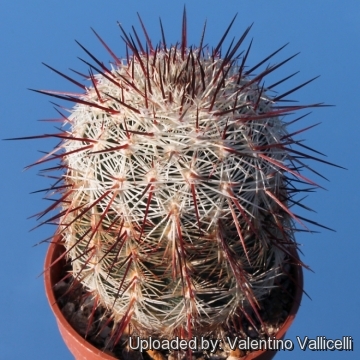 Echinocereus chloranthus (Echinocereus viridiflorus subs. chloranthus) Photo by: Valentino Vallicelli
Echinocereus chloranthus (Echinocereus viridiflorus subs. chloranthus) Photo by: Valentino Vallicelli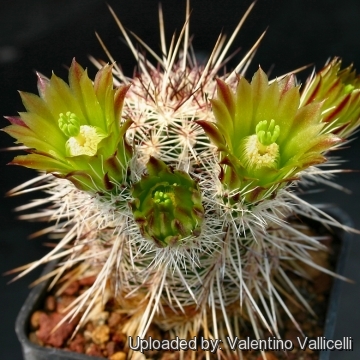 Echinocereus viridiflorus SB506 Dona Ana Co, NM, USA. (Echinocereus viridiflorus subs. chloranthus) Photo by: Valentino Vallicelli
Echinocereus viridiflorus SB506 Dona Ana Co, NM, USA. (Echinocereus viridiflorus subs. chloranthus) Photo by: Valentino Vallicelli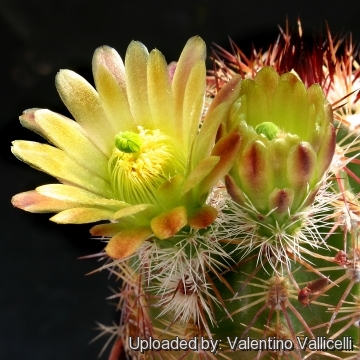 Echinocereus chloranthus (Echinocereus viridiflorus subs. chloranthus) Photo by: Valentino Vallicelli
Echinocereus chloranthus (Echinocereus viridiflorus subs. chloranthus) Photo by: Valentino Vallicelli Echinocereus chloranthus (Echinocereus viridiflorus subs. chloranthus) Photo by: Cactus Art
Echinocereus chloranthus (Echinocereus viridiflorus subs. chloranthus) Photo by: Cactus Art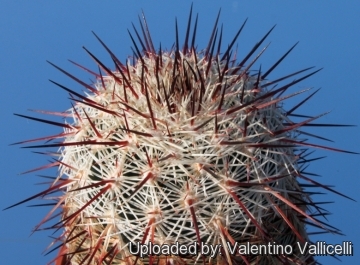 Echinocereus chloranthus (Echinocereus viridiflorus subs. chloranthus) Photo by: Valentino Vallicelli
Echinocereus chloranthus (Echinocereus viridiflorus subs. chloranthus) Photo by: Valentino Vallicelli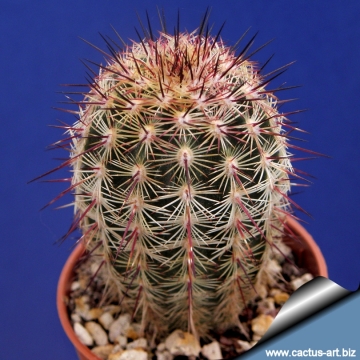 Echinocereus chloranthus (Echinocereus viridiflorus subs. chloranthus) Photo by: Cactus Art
Echinocereus chloranthus (Echinocereus viridiflorus subs. chloranthus) Photo by: Cactus Art Echinocereus viridiflorus SB506 Dona Ana Co, NM, USA. (Echinocereus viridiflorus subs. chloranthus) Photo by: Valentino Vallicelli
Echinocereus viridiflorus SB506 Dona Ana Co, NM, USA. (Echinocereus viridiflorus subs. chloranthus) Photo by: Valentino Vallicelli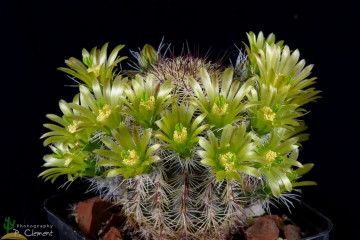 Echinocereus chloranthus (Echinocereus viridiflorus subs. chloranthus) Photo by: Peiffer Clement
Echinocereus chloranthus (Echinocereus viridiflorus subs. chloranthus) Photo by: Peiffer ClementCultivation and Propagation: In culture it is without problems and regularly shows its small greenish flowers if we provide an adequate winter rest period. They are re small plants with scented flowers that are better close to nose level. Displaying your cacti on shelves has the added benefit of keeping them off the ground and away from potential rodent or snail damage.
Soil: Use mineral well-permeable substratum with little organic matter (peat, humus).
Repotting: Repotting every 2-3 years. It will need a pot with sufficient depth to allow the tap root. As it is especially prone to rot under-pot in a smaller container filled with very porous compost. Use pot with good drainage.
Watering: Water sparingly from March till October, and keep perfectly dry in winter, at temperatures from 5 to 15 degrees centigrade. In the rest period no high atmospheric humidity!!Care must be taken with watering as they tends to become swollen and untidy in growth habit if given too much water and shade.
Exposition: Outside bright sun, filtered sunlight or afternoon shade, inside it needs bright light, and some direct sun. Subject to sunburn if exposed to direct sun for too long. Tends to bronze in strong light, which encourages flowering and heavy spine production.
Hardiness: Keep drier and cool in winter. Very cold resistant hardy to -10° C or less for short periods of time.
Fertilization: During the growing season enrich the soil using a fertilizer rich in potassium and phosphorous, but poor in nitrogen, because this chemical element doesn’t help the development of succulent plants, making them too soft and full of water.
Pests & diseases: It may be attractive to a variety of insects, but plants in good condition should be nearly pest-free, particularly if they are grown in a mineral potting-mix, with good exposure and ventilation. Nonetheless, there are several pests to watch for:
- Red spiders: Sensitive to red spider mite. Overhead watering is helpful in controlling mites.
- Mealy bugs: Occasionally mealy bugs they develop aerial into the new growth among the wool with disfiguring results, but the worst types develop underground on the roots and are invisible except by their effects.
- Scales: Scales are rarely a problem.
- Rot: Rot it is only a minor problem with cacti if the plants are watered and “aired” correctly. If they are not, fungicides won't help all that much.
Propagation: Seeds or cutting (if available). Seeds germinate in 7-14 days at 21-27° C in spring, remove the glass cover gradually as the plants develops and keep ventilated, no full sun for young plants! The seedlings should not be disturbed until they are well rooted, after which they can be planted separately in small pots.


















